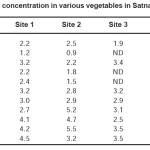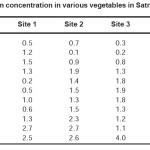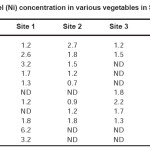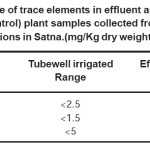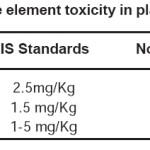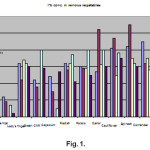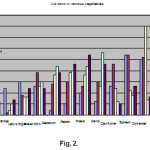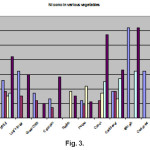Determination of Metals of Toxicological Significance in Waste Water Irrigated Vegetables of Satna Region
S. Tamrakar and Neelam Richhariya*
Vindhya Institute of Technology and Sceicne, Enginnering Chemistry Department, Satna - 485 001, India.
*Government Girls College,Satna - 485 001, India.
DOI : http://dx.doi.org/10.13005/msri/090205
Article Publishing History
Article Received on : 26 Jan 2012
Article Accepted on : 27 Feb 2012
Article Published :
Plagiarism Check: No
Article Metrics
ABSTRACT:
Untreated or partially treated wastewater is widely used for irrigation in water scarce regions in several countries including India. While the nutrients contained in the wastewater is considered as beneficial to agriculture, the contaminants present in wastewater pose health risks directly to agricultural workers and indirectly to consumers of the waste water grown product. In the present work effects of municipal waste water irrigation on the accumulation of heavy metals Pb, Ni and Cd in vegetables was investigated by monitoring waste water irrigated agricultural fields of Satna area. It was found that the vegetables grown with waste water had higher concentrations of metals than those irrigated with tube well water with highest concentration of all the metals found in Spinach i.e. Pd, Cd and Ni to be 5.5, 4.0 and 6.2 mg/Kg dry weight respectively.
KEYWORDS:
Municipal water; Trace element toxicity; Vegetables
Copy the following to cite this article:
Richhariya N, Tamrakar S. Determination of Metals of Toxicological Significance in Waste Water Irrigated Vegetables of Satna Region. Mat.Sci.Res.India;9(2)
|
Copy the following to cite this URL:
Richhariya N, Tamrakar S. Determination of Metals of Toxicological Significance in Waste Water Irrigated Vegetables of Satna Region. Mat.Sci.Res.India;9(2). Available from: http://www.materialsciencejournal.org/?p=1110
|
Introduction
Increasing scarcity of fresh water resources is driving many countries in the arid and semi arid regions to use municipal waste water, for irrigation with waste water is said to have both beneficial and harmful effects as it contains substantial amounts of beneficial nutrients and toxic heavy metals ( Chen et al., 2005; Singh et al., 2004). Reliability and nutrient richness are considered as two important attributes of waste water beneficial for agriculture. It is believed that nutrients present in waste water results in higher crop yields and thereby considerably reduces the need to apply artificial fertilizers. Reliability of wastewater supply is yet another factor which makes it a valuable resource as it contains large amounts of organic material and some inorganic elements essential for plant growth. But it also may contain non-essential heavy metals which when present in large amounts could be transferred to animal and human bodies through food chain (Gafoor et al., 1995; Nriagu, 1990).
Observation of population growth trends and national industrial development with consequential increase in discharge of waste water from factories and mines,it is predicted that the chances of increase in heavy metal contamination levels of soil and their entry into the foodchain, is increasing and a cause for alarm. Besides the various studies and investigation s regarding the impact of urban and industrial waste water on soil and plant characteristics, more specific information is needed in relation to the absorption and transfer of heavy metals from the root region to various types of leafy and other vegetables, especially the levels of accumulation of heavy metals in different parts of the cultivated crops and plants, under similar conditions; and other related research is required for preserving population health safety. Considering the importance, this study has been conducted to investigate the inorganic pollutants particularly heavy metals in the most common edibles i.e. the
vegetables, and determine their levels of concentration with reference to human health in the region of Satna. The heavy metals chosen for this study were Lead, Nickel and cadmium since they are most common pollutants of the environment.
Satna lying in the north eastern part of M.P., is located between 23058’ to 25012’, North latitude and 80021’ to 81023’East longitude. The economics of the district depends heavily on industries related to cement manufacture, flour and oilseed milling and agricultural products. The district comes under drought prone districts of the state within an average rainfall below 100cms. Due to shortage of water people are forced to drink polluted water and this non- availability of water is responsible for use of domestic and industrial waste water for irrigation of fields.
Material and Method
The vegetables collected for investigation were fruity vegetables- Tomato (Lycopersicum esculentum), Brinjal (Solanum melongena), Lady’s finger (Abelmoschus esculentus), Green Chilli (Capsicum annum) Capsicum (Capsicum longifolia); rooty vegetables- Carrot (Daucas Carota), Potato (Solanum tuberosum); leafy vegetables- Cauliflower (Brassica Oleracea), Spinach (Spinach oleracea), Corriander (Corriendrum sativum), Radish( Raphanus sativus) from six different sites in which 5 sites irrigated with effluents and possibly contaminated by the industrial effluent, while the sixth site irrigated with tubewell water considered as background sample. The five sites around the industrial area of Satna were selected for study. The industrial area of Satna has various units related to manufacturing of Polythene, Marble works, plastic works, ceramics and paper mills etc.
The samples were collected for two years 2008 and 2009.A total of fifty five effluent irrigated samples were collected and then washed with distilled water, oven dried at 70oC and then were ground to a fine powder. Aliquots of sample were digested in HNO3 and HClO4 mixture (Anonymous, 1984). Finally metal ions were determined with the help of atomic absorption spectrophotometer.( AAS 4141)
Results
Samples of industrial effluent mixed water varied greatly in heavy metal concentrations. Results in Table I shows that almost all the vegetables examined here were found to contain Lead. Among fruity vegetables Lady’s finger had the highest conc. with 3.4 mg/Kg dry weight in S III, while in rooty vegetables potato and carrot showed a conc. of 4.0 mg/Kg dry weight both in S IV, with highest in Carrot of 5.2 mg/Kg dry weight in S II. The highest concentration was present in leaves of Spinach showing 5.5 mg/Kg dry weight in SII. The least concentration was found in brinjal to be 0.2 mg/Kg dry weight. The range of Lead in various vegetables is shown in Table IV.
The maximum permissible levels of Cd in food as per IS is 1.5 mg/Kg dry weight. The highest concentration of Cd found in fruity vegetables was in Capsicum to be 2.2 mg/Kg dry weight of S IV. Among roots highest concentration was in carrot 2.8 mg/Kg dry weight of S IV. Among all the vegetables, the highest was in Spinach 4.0 mg/Kg dry weight of S III. The least of Cd was found in Brinjal to be 0.1 mg/Kg dry weight of S II. Range of Cd in various vegetables is given in Table IV.
Table 1: Lead(Pb) concentration in various vegetables in Satna Region (mg/kg)
Table 2: Cadmium concentration in various vegetables in Satna Region (mg/kg)
Table 3: Nickel (Ni) concentration in various vegetables in Satna Region
Table 4: Range of trace elements in effluent and tubewell irrigated (control) plant samples collected from various regions in Satna.(mg/Kg dry weight)
Table 6: Trace element toxicity in plant samples
Figure 1
Figure 2
Figure 3
The allowable concentrations of Ni in food is 1-5 mg/Kg dry weight as per BIS. Data in Table III shows that most of the samples had Ni concentration below the permissible limits.The highest among fruity vegetables was found in brinjal to be 4.2 mg/Kg dry weight in SV. Among rooty vegetables highest was found in Carrot to be 5.7 mg/Kg dry weight, in SV. Leafy vegetables showed maximum concentration in Spinach as 6.2 and 6.2 mg/Kg dry weight in SI and SV.
However, tube well water samples were almost similar in nature with metal concentrations under permissible limits. It was observed that the concentration of
all the three metals detected was in the order Leaf> root > fruit.
Discussion
The result of the study shows that most of the vegetables are contaminated with heavy metals. Heavy metal depositions are associated with a wide range of sources such as small scale industries (including battery production, metal products, metal smelting and cable coating industries); brick kilns, vehicular emissions, resuspended road dust and diesel generator sets. These can all be important contributors to the contamination found in vegetables. In general coal combustion is an important source as Indian coal is of relatively poor quality and has high heavy metal contents.
Additional potential sources of heavy metals in field locations in urban and peri-urban areas include irrigation water contaminated by sewage and industrial effluent leading to contaminated soils and vegetables , other sources can include unsafe or excess application of (sometimes banned) pesticides, fungicides and fertilizers such as sewage sludge(Krishna Murti 1989).
In the present work the higher contents of heavy metals were found in vegetables irrigated with waste water which may be attributed to the fact that waste water was composed of various types of domestic and industrial effluents, which contained a variety of chemical compounds.
Almost all the samples had Pb concentration higher than the permissible limits of 2.5 mg/Kg of dry weight similar to the work done by Hussain et al., (2006) where almost all the vegetables had higher Pb concentrations. Investigations done by R.Raza (2005) on vegetables grown with industrial effluents reported Pb concentrations as 242.5, 46.3 and 64.8 mg/Kg of dry weight for spinach, sponge gourd and tomatoes resp. Chakraborty et al.,(2004) studied heavy metal concentration in some vegetables from north eastern region of India and reported lead concentration being highest in leafy plants with 31.8 mg/kg of dry weight in spinach leaf, similar to the present work. H.Lokeshwari et al., (2006) studied heavy metal contamination of Bellandur Lake on soil and cultivated vegetation and reported highest concentration of Pb in brinjal and beans as compared to other vegetables. Studies have shown that uptake and accumulation of metals by different plant species depend on several factors and various researchers have identified various reasons( Bingham. et al.,, 1975; Dowdy et al.,, 1978).Chandrappa et al., (2006) found Pb concentrations to be highest in roots of water hyacinth i.e 33μg/g. Anhwange, B.A.,J.A Kagbu et al., studied trace metal contents on common vegetables grown on irrigated farms and reported highest concentrations in spinach which was 0.15 mg/Kg which is much below than 0.3mg/kg set as a threshold limit for safety by WHO. Saif and Haque (2005) reported lead concentrations in spinach leaf collected from sewage irrigated area and compared it with tubewell irrigated spinach leaf .It was found that the plant with tubewell water irrigation had Pb concentrations under permissible limits but effluent irrigated plant had concentrations ranging from 0.5- 64.0mg/Kg of dry weight as concluded in the present work.
Nickel
H.Lokeshwari et al., (2006) studied heavy metals in water, water hyacinth and sediments of Lalbagh tank, Bangalore and reported maximum value of Ni in water hyacinth sample (root part) which was 8 μg/g. The high concentration was attributed to the concentration effect in water during summer. Saif and haque (2005) in their investigation found Ni concentrations in Spinach leaf irrigated with effluent mixed waste water ranging from 26.95mg/Kg dry weight to 88.0 mg/Kg
dry weight.
Midrar-ul-haque et al., (2005) in their work found Ni concentration in vegetables grown in Korangi industrial area, Karachi Pakistan to be 88 mg/Kg of dry weight. They found that 93% of the samples analyzed by them had concentration higher than the permissible limits.
Trace elements are absorbed by plants from soils as well as partly from water and air. Some of these elements are essential for their normal growth while others are toxic and hence have ill effects on their growth while it has recently being established that Ni is essential to higher plants.
Cadmium
The maximum permissible levels of Cd in drinking water, soil and food as per IS are 0.01mg/ Kg, 3.6mg/Kg and 1.5 mg/Kg respectively. H.Lokeshwari et al., found Cd in samples of water and water hyacinth much below the permissible limits. Cd is considered as a potential toxin that isprincipally dispersed in natural and agricultural environments through anthropogenic sources. Untreated municipal sewage, often a potential source of Cd is generally used to irrigate urban agricultural soils in many developing countries. M.Qadir et al.,(2000) studied Cd concentration in vegetables grown on urban soils irrigated with untreated municipal sewage and concluded that leafy tissue accumulated Cd about twice that of the fruit portion. Anhwange et al., (2009)found Cd concentration in the range 0.06-0.11mg/Kg in some common vegetables analysed by them.The highest conc.0.11mg/Kg was found in Capsicum annum which is about the maximum value set by the the WHO standards for vegetables. According to Carl et al., (2003) excess Cd reduce phosphate level in bones and serum leading to fragile bones. H.Lokeshwari and G.T. Chandrappa(2006) in their study of impact of heavy metal concentration of Bellandur lake on soil and cultivated vegetation found the presence of Cd in spinach (4μg/g) and radish (2.5 μg/g)which was beyond the set limits. They concluded that total concentration of Cd in plant foodstuff was 21 times higher than the natural concentration. Overall comparison revealed that the metals in water had more impact on vegetation than the soil itself.
M.Saleem Saif et al., (2005)in their work found Cd in spinach leaf ranging from 0.85-74.0 mg/kg dry weight. They found that 25% samples had Cd concentration higher than the permissible limits. Bigdeli et al., (2008) concluded that Cd concentration mostly were appeared in leafy vegetables and follows the order Radish leaves >Cress > Radish roots> Dill>Spinach>egg plant. Giordano and Mays showed that among different vegetables, the highest amounts of Cadmium accumulation is in lettuce, spinach and radish. Shariati and Farshi (1999) also showed that the levels of Cadmium accumulation are in a descending order in lettuce, radish and spinach, respectively. Torabitni and Mahjouii (2002) show that Cadmium accumulation in plants irrigated with wastewaters in South Tehran is in the following order of ranking. Spinach<Radish<Coriander<Mint. The amount of Cadmium accumulation in the aerial parts of a plant is higher than in the parts below the ground (root). This finding is comparable with the findings of other earlier studies. It has been reported that cadmium is a highly mobile metal, easily absorbed by the plants through root surface and moves to wood tissue and transfers to upper parts of plants. Permissible limits of consumption of Cadmium for human beings, is 70 μg/day.
Conclusion
In conclusion, this study has revealed that various metals studied are higher than the permissible limits. Table V shows that 60% samples had Pb concentration higher than the permissible limits.30% samples had Cd higher than the recommended value while Ni is less problematic in the area with only 5% samples having concentrations higher than the recommended values of BIS. These findings are indicative of industrial pollution. Although the essential elements are beneficial to man and plants, when found in excessive amounts well above the levels normally found in food, can prove detrimental to health. This is more so when they exist in commonly consumed food crops, particularly the green vegetables which are generously consumed by all households especially during the season of abundance. Leafy vegetables have been shown to accumulate relatively high concentrations of heavy metals in compare to fruit vegetables. Although there is a general tolerable level of metals in vegetables from Satna at the moment, there are exceptional cases of metal build up such as Cadmium and Lead in feature. The daily intake of these metals at present is much less than concentrations that affect health, the situation could however change in the future depending on the dietary pattern of the community and the volume of contaminants added to the ecosystems.
In view of these findings, there is need to monitor more closely the environment under review and put in place appropriate checks and balances to preserve the health of communities within the vicinity of the industrial areas, particularly as the effects of heavy metals are bioaccumulative and pose great dangers to the health of humans, animals and plants.. Moreover excessive use of this water is not only toxic for crops but also for soil health.
On the basis of these results following recommendation are made for future sustainability of agriculture resources:
Treatment of industrial water at point source is the best remedy for consumers. Industrialists should take this responsibility
Irrigation of drainage water should be followed by heavy irrigation to canal or groundwater of good quality.
Government should ensure the canal water supplies for the farmers using this polluted water. And the industrialists play a key role in this participatory approach.
Leafy vegetables should not be sown at this area
References
- Anonymous. Official methods of analysis. AOACInc., Arlington, VA, USA (1984).
- Bigdeli Mohsen and Seilsepour Mohsen Investigation of Metals Accumulation in Some Vegetables Irrigated with Waste Water in Shahre Rey-Iran and Toxicological Implications American-Eurasian J. Agric. & Environ. Sci., 4(1): 86-92 (2008).
- Carl A.Brutis and Edward R Ashwood Fundamentals of Clinical Chemistry,Fifth edition McGraw Hill companies Inc. New York pp33, 5 68, 571-658 (2003).
- Chakraborty,Rahul.Dey,Sudeep et al., Determination of few heavy metals in some vegetables from north eastern region of India in Relation To Human Health. Poll.Res. 23(3): 537-542 (2004).
- Dowdy, R. H., Larson, W. E., Titrud, J. M. and Latterel, J. J., Growth and metal uptake of snap beans grown on sewage sludge amended soil – A four year field study. J. Environ. Qual., 7: 252–257 (1978).
CrossRef
- Farshi, A.A., M.R. Shariati, R. Jarollahi, M. Shahabifar and M.M. Tavallaei, An estimate of water requirement of main field crops and orchards in Iran. Vol. 1: Field crops. Soil and water Research Institute (1999).
- H. Lokeshwari and G. T. Chandrappa Department of Chemistry, Central College Campus, Bangalore University, Impact of heavy metal contamination of Bellandur Lake on soil and cultivated vegetation. Current science, 91(5): (2006).
- Haq,Midrar-ul.et al., .Toxicity of trace Elements in Different Vegetables Grown on Potentially Contaminated sites of the Korangi Industrial Area, Karachi Pakistan. Asian Journal of Plant Sciences 4(2): 132-135 (2005).
- Hussain S. Iqrar, Ghafoor Abdul, Ahmad Sagheer, et al., Irrigation of Crops with Raw Sewage:Hazrd assessment of Effluent, Soil and Vegetables Pak. J Agri Sci., 43(3-4): (2006).
- M.Qadir, A.Gafoor. Cadmium concentration of vegetables grown on urban soils irrigated with Untreated municipal sewage. Environment, Development and Sustainability 2: 11–19 (2000).
CrossRef
- R.Raza.Investigation of Trace Metals in Vegetables Grown with Industrial Effluents. Jour. Chem. Soc. Pak. 27(4): (2005).
- Singh, M. Kumar, Heavymetal load of soil,water and vegetables in peri-urban Delhi, Environ. Monit. Assess. 120(1-3): 71–79 (2006).
CrossRef
- Chen, Y., Wang, C., Wang, Z., ‘Residues and source identification of persistent organic pollutants in farmland soils irrigated by effluents from biological treatment plants’. Environment International 31: 778-783 (2005).
CrossRef
- Giordano, P.M. and D.A. Mays, Yield and heavy metal content of several vegetable species grown in soil amended with sewage sludge. In Biological Implications of Heavy Metals in the Environment. ERDARep. Conf. 750929, Oak, Ridge, Tennessee (1977).
- Nriagu, J.O. and J.M. Pacyna, Quantitative assessment of worldwide contamination of air, water and soil by trace metals. Nature, 33: 134–9 (1988).
CrossRef
- Ghafoor, A., A. Rauf, M. Arif and W. Muzzafar, Chemical composition of effluent from different industries from Faisalabad city. Pakistan J. Agric. Sci., 31: 37-69 (1995)
- Fazeli, M.S., Enrichment of heavy metal in paddy crops irrigated by paper mill effluents near Nanjangud, Mysore District, Karnatake, India Environmental. J. eology, 34: 42-54 (1998).
- Torabian, A. and M. Mahjouri, Heavy Metals uptake by vegetable crops irrigated with waste water in south Tehran. Journal of Environmental Study. 16(2): (2002). (In Persian).

This work is licensed under a Creative Commons Attribution 4.0 International License.
 Material Science Research India An International Peer Reviewed Research Journal
Material Science Research India An International Peer Reviewed Research Journal

